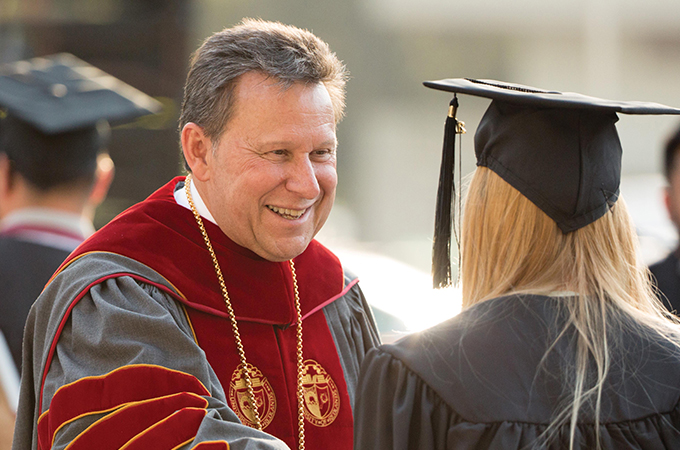To mark the occasion of Ralph W. Kuncl’s departure from the U of R presidency at the end of June, Och Tamale magazine and the Bulldog Blog partnered with Ellie Obrochta ’19, one of the many people Kuncl has mentored over the years, to interview him about the highlights of the last nine years and his vision and hopes for the future of the University. (The interview has been edited for length and clarity.)
Ellie Obrochta ’19 for Och Tamale/Bulldog Blog: How did you approach the job of being University President?
Ralph W. Kuncl: Despite many competing priorities as President, I tried to keep in mind the importance of relationships, as well as the big-picture direction of the institution. The critical decisions are the ones that have a long-term impact, shaping the University’s future potential—not next year, but 20 or 30 years in the future. The focus is always on the future and the possible.
OT: What were the biggest challenges?
RWK: Many positions at the University serve one constituency or another—be it students, faculty, staff, alumni, trustees, donors and University friends, or the local community. The President serves all of them. We’ve had plenty of situations that are controversial, whether it’s racial injustice in America or the pandemic. Everyone has valid opinions, but the President has to counterbalance all of the competing views and carefully navigate the constituencies.
OT: What were the biggest satisfactions of the job?
RWK: It is satisfying to be able to make an impact on the issues one cares about and to help expand the future opportunities for this University, and I’ve been able to do that to a large extent. Mentoring is one area that is very meaningful to me. As many people will tell you, I find it tremendously rewarding to help faculty and students achieve their professional goals. I hope I’ve made a little difference in their lives; they’ve made an enormous impact on me.
[Watch the following video, “Overview: The Kuncl Presidency.”]
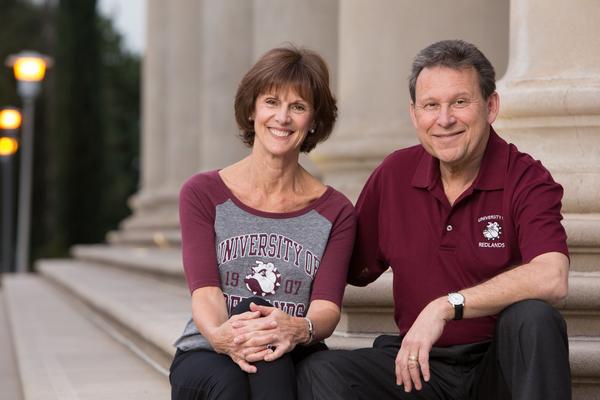
The coming train station
OT: Construction crews are working on the final stages of the Arrow line train route. How did the rail station come to be part of your vision for the University?
RWK: The rail station was part of my vision for the University from the beginning. I mentioned it in my inauguration address in 2013. When I got to Redlands, I asked myself: “What is the biggest asset the University isn’t using?” The answer was real estate. I thought the 30 acres of dirt and wild growth on the southern part of the main campus could be transformed into a vibrant destination by the train station and a surrounding University Village. I imagined the space would feature pubs and fine dining and boutiques, perhaps also a green grocer, a coffee house, and open green spaces where musical ensembles could perform in the evening. The Village would also feature high-quality, multigenerational residences that would be attractive to faculty, alumni, graduate students, and the community. All of that is going to become a reality in the future.
OT: Where are we now in terms of the rail station and University Village development?
RWK: We can think of the project in three parts: the rail tracks, the station pavilion, and the eventual University Village. The rail tracks are the furthest along. The San Bernardino County Transportation Authority is soon to begin testing the rail line with old diesel engines. Actual passenger service on sleek new energy-efficient trains is slated to begin in early 2022. The station was completed in early May. What’s amazing is that people will get off of the train and land on a platform with a pavilion, and it will look like it’s been there forever on the University campus because it’s architecturally aligned with the rest of the University’s iconic buildings. The Village itself will take longer. We’re at the stage now where there has been a request for proposals, or RFP, that, through competition, will result in the selection of a master developer who will over years acquire investors and will envision, design, and construct that Village in phases.
OT: In 20 years, how do you think the rail station will shape the University?
RWK: It’s inevitable—in 20 years, the University community will take entirely for granted the rail station, train service, and University Village. The train will connect Redlands and all of Southern California, making it easy for prospective students to visit our campus and for our students to take advantage of volunteer service, recreational, and internship opportunities across Southern California. That will be transformative. In addition to being a social and cultural destination, the project will also create economic development for the City of Redlands and the University, helping to support everything we do.
[Watch “The Rail to Redlands.”]
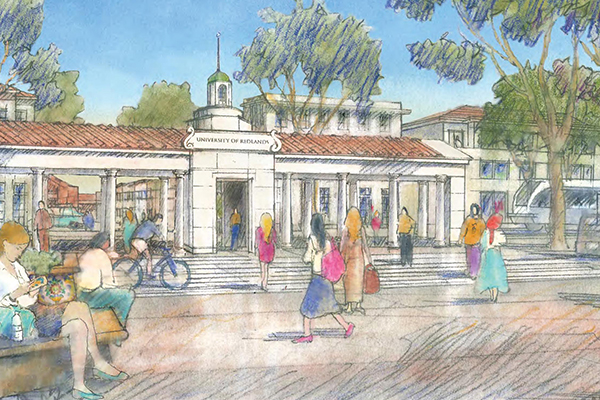
Addition of the Marin campus
OT: The University of Redlands’ merger with the San Francisco Theological Seminary (SFTS) in July 2019 was one of the most significant changes during your time as president. Was a merger something you had planned to do during your presidency?
RWK: A merger was not something anyone could have planned on. But it’s important to have a prepared mind, and, in our strategic planning process North Star 2020 led by Provost Kathy Ogren, we thought about the possibility of partnerships with the right kind of institution. Such a major undertaking would only be considered if it enhanced the University of Redlands’ mission and strategic goals. And that’s the opportunity that came along. To be successful, I’ve always said that a merger has to involve institutions that are financially complementary and culturally aligned. Those are the two things that can kill a merger and frequently do. But there also needs to be more: “One plus one equals two” is not interesting; “one plus one equals three” is very interesting. Our merger/acquisition created a new Graduate School of Theology and a new campus to host new interdisciplinary academic programs, as well as conferences and events.
OT: What advantages did you see in the merger?
RWK: The University of Redlands gained a pristine 19-acre campus in Northern California only 15 miles north of the Golden Gate Bridge, a significant endowment, and a highly regarded graduate program in theological studies. SFTS maintained its identity and 150-year-old purpose as a seminary and stabilized its financial outlook. Both institutions expanded opportunities for their students and alumni. For the U of R, that includes internships, mentorships, and networking within the dynamic Bay Area. For SFTS, that means access to education on such diverse topics as management, counseling, leadership, and nonprofits.
OT: In 20 years, what do you see as the Marin campus’s role within U of R?
RWK: If we activate the potential of the Marin campus, the University will thrive. Geography will no longer limit us: one university, but multiple places, both real and virtual. In 20 years, I see the Marin campus as a multidisciplinary center with programs not only from the Graduate School of Theology, but also the Schools of Business, Education, Music, and Continuing Studies, as well as vibrant collaborations among our schools—just one example might be a degree in liturgical music. The Marin campus will also become a sought-after conference center that leverages the incredible location and facilities there.
[Watch “Addition of the Marin Campus.”]
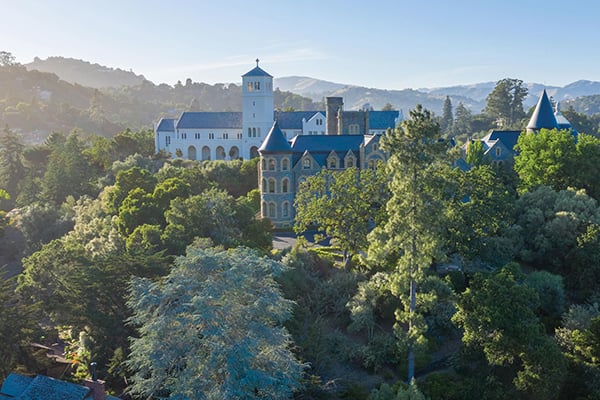
Our House celebration
OT: One of the occasions you introduced into the academic life of the University was Our House, an annual celebration of creative and scholarly work. What was the origin of the Our House celebration?
RWK: The name for Our House came from [Professor] Art Svenson’s brilliant spoken word performance at my inauguration ceremony on Feb. 20, 2013, when he looked at me directly and said, “Take care of our house!” In that moment I felt the weight of the responsibility to not merely lead but take great care. While many academic institutions have some sort of formal celebration of scholarship, I noticed that was a missing element at Redlands. So, with the provost, I designed a way to publicly present and exhibit scholarly research to broad audiences, to celebrate that work.
OT: What has been the result?
RWK: Our House is now an annual program recognizing the diverse creative and scholarly talent of our faculty and staff. I am continually impressed to see the variety and creativity involved, whether it is poetry, musical compositions, politics, languages, scientific research, or accounting handbooks. Trustees have paid attention and learned more about the University’s scholarship.
OT: In 20 years, how do you see Our House making a contribution?
RWK: Since Our House encapsulates a core aspect of the University of Redlands—its intellectual and creative life—I think Our House is here to stay and will continue to enrich the life of the University for decades to come.
[Watch “Our House Celebration.”]
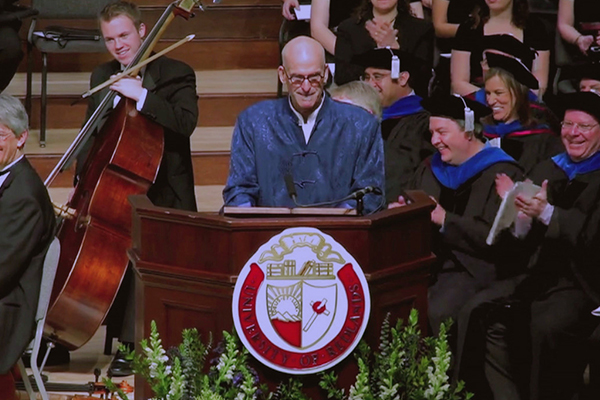
Forever Yours fundraising campaign
OT: The nine years of your presidency have coincided with all phases of the Forever Yours campaign, which has almost reached its goal of raising $200 million. What were your initial thoughts about the campaign when you started the job as President?
RWK: When I was interviewing for the position of President, I said, “If you hire me, the campaign starts today, and I will seek to double the endowment.” And that’s what we’ve done. Of course, it takes a dynamic team. We’ve nearly met the $200 million goal—we’re almost there.
OT: What was a highlight of the campaign for you?
RWK: One moment that mattered greatly in the campaign was when the late Rich Hunsaker ’52 and Ginnie Hunsaker ’52 made a transformational $35 million pledge—the largest gift in the University’s history—to establish the Hunsaker Scholarship Prize. The scholarship is awarded annually to a select number of exceptional and entrepreneurial incoming students from diverse backgrounds who will become leaders in society and will follow the Hunsakers’ example by giving back to their communities and the University.
OT: What will the long-term impacts of the campaign be—in 20 or 30 years?
RWK: The University will experience more financial stability and a greater ability to withstand crises because of its expanded endowment. And the person who will break the Hunsakers’ record gift to the University could be a Hunsaker Scholar.
[Watch “Forever Yours Fundraising Campaign.”]
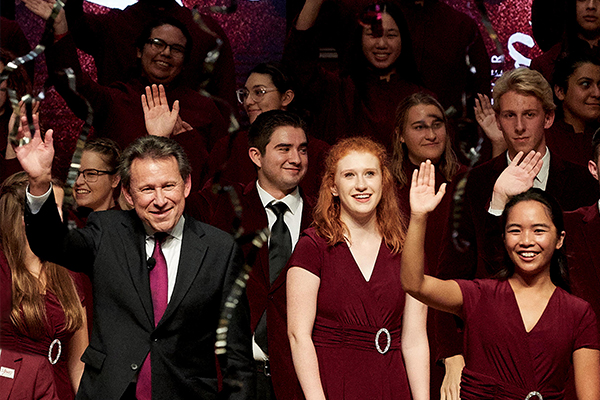
COVID-19 and the Redlands community
OT: It has been quite a year, with the pandemic and all that’s involved in responding to these once-in-a-lifetime circumstances. As an M.D., how did you approach the problem of keeping the University community safe?
RWK: As a medical professional, I was earlier than most in January 2020 in seriously considering that COVID-19 could become a pandemic. After all, in my academic and medical career I had lived through six of the worst pandemics in history: Hong Kong Flu of 1968, HIV/AIDS of 1981 to present, SARS in 2003, H1N1 Swine Flu of 2009, and Ebola and Zika of 2014. In mid-February 2020, I put together a team to convene and take charge in case the “novel coronavirus” became a public health emergency; I knew we would need to make critical decisions on supplies, communications, and procedures if a pandemic emerged. I had hoped we were overpreparing, but unfortunately, these turned out to be necessary precautions. Throughout the pandemic’s duration, our University community’s health and safety, as well as that of our friends and neighbors, were my highest priority. I always quoted the most authoritative medical sources
(that’s the “Fauci effect”) and tried to use common sense.
OT: Could you describe the impact of COVID-19 on the University?
RWK: COVID-19 has affected every aspect of our operations and every member of our community. Yet, we have continued to pursue diligently our goal of delivering a personalized education to our students. Professors, students, staff, and alumni have risen to the occasion by being adaptive and creative. In addition, the University’s role as an anchor institution in the community really stands out. This included donating more than 13,000 pounds of food for those in need; partnering with Loma Linda University to open a walk-in medical clinic for the homeless; working with the County of San Bernardino to provide a COVID-19 testing center; and collaborating with Redlands Community Hospital to launch a vaccination clinic on the Redlands campus. We prayed for health and safety. But I believe in action: as the late Congressman John Lewis said, “When I pray, I move my feet.”
OT: In 20 years, what do you think the effects of the pandemic will be?
RWK: Unfortunately, human memory means many of us will have comfortably forgotten lessons learned, just like the 1918 influenza pandemic. Some things, like wearing face coverings and hosting virtual conferences, will remain part of our culture. However, the spirit with which we met the pandemic—the determination, innovation, and compassion—are qualities that are part of the DNA of this institution and will last far longer than the next 20 years.
[Watch “COVID-19 and the Redlands Community.”
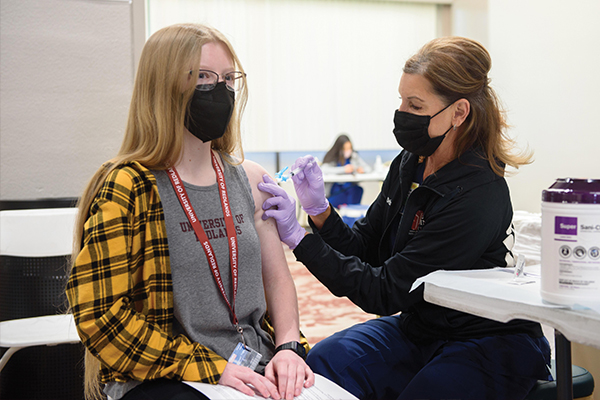
Music
OT: Anyone who knows you knows that you love music and enjoy performing as an amateur vocalist. Have there been any changes to the music programs since your arrival?
RWK: I believe the music programs, in general, have thrived since I have been here, including a new master’s in vocal chamber music. The School of Music’s success probably has little to do with me, though, and a lot to do with the steadily increasing creative talent of faculty and students. One event I did elevate is the President’s Honor Recital. I took a personal interest and tried to engage the audience for these wonderful performances by personalizing the featured students, who were selected through auditions.
OT: What were some of your favorite memories of your presidency?
RWK: They have to do with musical performance, of course. I remember walking through the streets of Manhattan in 2013, parading with U of R’s Nicholle Andrews and the choristers towards Carnegie Hall, where I joined the University of Redlands choirs in a performance of Mozart’s Requiem. Then there was a performance of Verdi’s Requiem with Joe Modica [now director of the School of Music] in Hollywood, in 2014, which was a fundraiser for the Wounded Warriors Project. Perhaps one of the greatest highlights of my time was the chance to perform with the choirs and University orchestra in the 2014 Feast of Lights conducting Handel’s Hallelujah Chorus. At the four performances, I had a trick up my sleeve for the students in the orchestra—I conducted about 10 beats faster each night until, on the last night at breakneck speed, they couldn’t believe the excitement in the air. Maybe the most fun experience for me was when I won a chance to conduct the Redlands Symphony Orchestra playing the National Anthem. That idea seemed just too ordinary. So I invited Angel Blue ’05, our alumna and now Metropolitan Opera star, to join me by singing and improvising. It was extraordinary.
OT: What do you see as the role of music at the University in 20 years?
RWK: Of course, music will continue to be a distinctive and enriching part of the University of Redlands, as new generations of students and faculty embrace all that the music program has to offer. I see a future with a robust, interdisciplinary performing arts program and center, with music, theater, dramaturgy, and dance.
[Watch “A Passion for Music”]
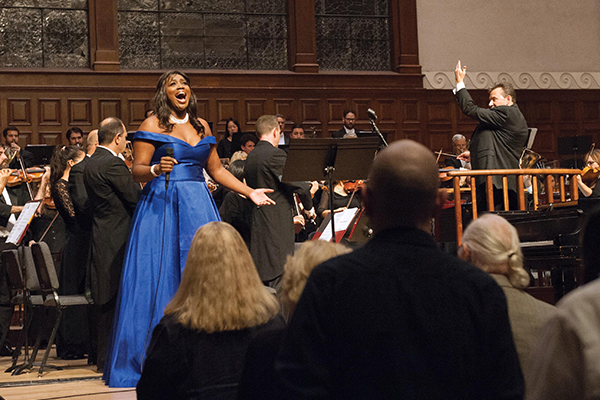
Looking ahead
OT: You are stepping down from the presidency at the end of this academic year. What is ahead for you?
RWK: I am reminded of what Cornel West said about faith: “We’ve forgotten that a rich life consists fundamentally of serving others, trying to leave the world a little better than you found it. … In many instances we will be stepping out on nothing, and just hoping to land on something.” I have faith it won’t be long before I am fully immersed in other meaningful pursuits—which already encompass several nonprofit and corporate board memberships, including chairing the Board of Directors of the Tuition Plan Consortium [the parent of the Private College 529 Plan with its 300 member colleges and $400 million in assets under management] and as a director of the fintech firm three+one [a national start-up corporation providing financial services, liquidity analysis, and banking RFPs].
OT: What message do you have for the U of R community?
RWK: There is enormous potential for this University, and now it is up to you, members of the Bulldog community, to decide what to make of it. Take my vision of the Marin campus and the University Village and its train … and do great things. Vision alone is not enough; you have to make things work. As scripture goes, “Without vision, the people perish.” But with vision, you’ll have a university that is truly compelling.
Explore the Summer 2021 issue of Och Tamale magazine.

